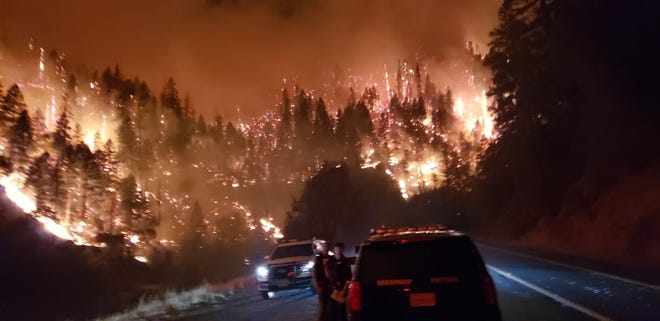- hot-spots
- forest fire
- USA
- California wildfires

Problems
The problem of wildfires in California
California has dry, windy, and often hot weather conditions from spring through late fall that can cause moderate to severe wildfires. The land area in California is 99,813,760, or approximately 100 million acres, and the area burned annually ranges from 90,000 acres, or 0.09%, to 1,590,000 acres, or 1.59% of the total California area. Forest fires in California are becoming increasingly dangerous because of the accumulation of wood fuels in the forests, population growth, and an increase in power lines and distribution. Sometimes these wildfires are swollen or exacerbated by strong dry winds known as Diablo winds in the northern part of the state, and Santa Ana winds in the south. Large fires can result in billions of dollars in losses.
Largest fires
The following is a list of the five largest wildfires in California. In California history, fires have burned more than 6.5 million acres - more than twice the size of Santa Clara, San Mateo, Alameda, Contra Costa, San Francisco, and Marin counties combined. ● Augusta Complex. August Complex, a series of lightning-induced fires that broke out in August 2020, burning 1,032,648 acres of land in Mendocino, Humboldt, Trinity, Tehama, Glenn, Lake, and Colusa counties. It destroyed 935 structures and caused one death. ● Dixie Fire. The active Dixie Fire began in July and burned 960,583 acres in Butte, Plumas, Lassen, and Tehama counties. 1,329 structures were destroyed and one person was killed. The cause is still being investigated. ● Mendocino Complex. The Mendocino Complex, a series of fires that began in July 2018, burned 459,123 acres in Colusa, Lake, Mendocino, and Glenn counties. The complex destroyed 280 structures and caused one fatality. The ranch fire, which was the largest fire in the complex, was started by a Potter Valley rancher who drove a stake into the ground to try to plug a hornet's nest and caused a spark in the dry grass. ● SCU Lightning Protection Complex. The SCU Lightning Complex, a series of lightning-induced fires in Stanislaus, Santa Clara, Alameda, Contra Costa, and San Joaquin counties, began in August 2020 and burned 396,624 acres. The fires destroyed 222 structures. ● Creek Fire. The Creek Fire, which started in September 2020, burned 378,895 acres in Fresno and Madera counties. It destroyed 853 structures, and the cause has not been determined. The fires have become the most destructive in recent years. Four of the five largest fires in California history have occurred since 2020.
Why the fires are happening
The conditions that set the stage for the staggering escalation of wildfires in California are multilayered and complex, but the climate emergency is the primary cause. The climate crisis has intensified drought and heat, two factors that have always been natural elements of the western landscape, but play a crucial role in the emergence of larger fires. As early as spring, when the landscape is usually still lush and green because of the winter rains, the region is showing signs of historic drought. The hillsides turn brown, bushes shrivel, and the dense layer of fall that is usually wet at this time, which collects and decomposes in the forest floor, quickly dries out. The landscape is prone to fire much earlier, increasing the risk that small pockets of fire quickly turn to hell. Another factor is heat. Abnormally high temperatures help remove the last of the moisture from the environment. They have become a formidable precursor to thousands of fires, which quickly turn into high and high-temperature fires. Drying out and heat-induced fires behave erratically, throwing sparks and embers for miles, traversing fire breaks, and crossing terrain once thought to be fire-free. Firefighters have encountered conditions they have never encountered before, making fires harder to put out and, in some cases, nearly impossible to stop.
Gallery
13Timelines
2022
September 10
The 2022 California wildfire season is an ongoing series of wildfires burning throughout the U.S. state of California. As of 5 September 2022, a total of 6,055 fires have been recorded, totaling approximately 241,074 acres (97,559 ha) across the state. The 2022 season follows the 2020 and 2021 California wildfire seasons, with the highest and second-highest (respectively) number of acres burned in the historical record. Several significant wildfires have burned already in California this year, including the destructive Oak Fire in Mariposa County, which burned over 180 structures, and the destructive and fatal McKinney Fire in Siskiyou County, which caused 4 fatalities
2021
October 11
In terms of the devastating effects of wildfires, 2021 is considered a terrifying year in the American West. In the first nine months of 2021, there have already been 11 wildfires in the U.S. with more than 100,000 acres. The Dixie Fire razed the city of Greenville to the ground. The Caldor Fire forced tens of thousands of people to evacuate Lake Tahoe. Some fires released plumes so high into the atmosphere that toxic air reached the East Coast - thousands of miles away from the blaze.
2020
June 03
The severe wildfires that swept across the U.S. state of California in the summer of 2020 destroyed approximately 10-14% of all giant sequoias that existed in the world. The loss of 7,500 to 10,600 giant sequoias, many likely thousands of years old, is devastating. Giant sequoias, the oldest of which are over three thousand years old, grow naturally only on the U.S. Pacific Coast. They reach up to 90 meters in height with a trunk diameter of up to eight meters.


